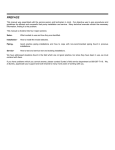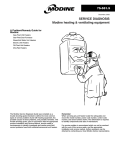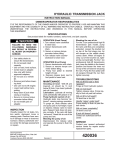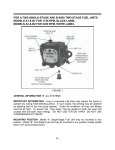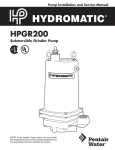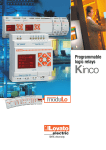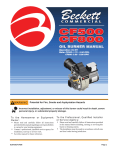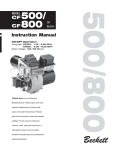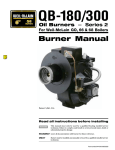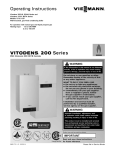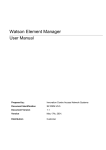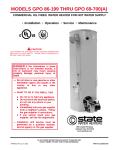Download Word Pro - Installation and Service Manual - Section IV
Transcript
SERVICE Service on fuel units should not be attempted without the aid of good vacuum and pressure gages. Many system problems can be detected with the aid of these gages. Service falls into two categories: routine and trouble. ROUTINE · ANNUAL OR OTHER CHECK OUT Check line filter and pump strainer for amount of contaminate. If close to needing service, replace to prevent a call-back in near future. If using inlet into the side of the pump, it isn’t necessary to remove cover to check the strainer. Remove inlet line and view strainer through inlet opening. If it’s clean there, it will be clean the rest of the way around. If strainer is plugged, remove cover and clean strainer with a brush and clean fuel. Replace cover gasket before reinstalling. System running vacuum should be checked as part of routine. Running vacuum should not exceed: 9 6 inches mercury for single-stage one-pipe. 9 12 inches mercury for single-stage two-pipe. 9 17 inches mercury for two-stage two-pipe. 9 Check and adjust system pressure, if necessary. 9 Check CO2 or O2 and system draft. 9 Check for smoke and adjust to a trace. Zero smoke is unclear as to where you are in adjustment. 9 Check for leaks at fittings and filters. Correct any leaks that are found. TROUBLE CALL In response to a trouble call, approach the problem in a logical and systematic sequence. Jumping to a conclusion can sometimes temporarily fix the problem, but not uncover the root cause of the problem. An example is if there is water in the fuel, which causes the pump to fail and you replace the pump only, you will eventually be called back to replace the new pump. In addition to the mechanical tools required, you also must have gages (pressure and vacuum) and suitable combustion analyzers. IV-1 SYSTEM TROUBLESHOOTING • DIAGNOSTIC FLOW CHART Follow a logical equence of troubleshooting from the no-heat call through to system operational using the following chart or similar sequence. Step 1 p No heat 2 Yes p Check for oil in tank No p Have oil delivered 3 Yes p Check to see that all valves are properly positioned (open or closed) No p Set valves to correct position 4 Yes p Check for line voltage at primary control No p Check and correct electrical supply 5 Yes p Check to see that thermostat is calling for heat No p Set, fix or replace thermostat 6 Yes p Check combustion chamber for excess oil Yes p Clean, remove or replace combustion chamber 7 No p Disconnect nozzle line from burner. Place container under nozzle line and start burner. 8 Yes p Motor comes up to speed. Audible click when start windings drop out. 9 Yes p Ignition working 10 Yes p Steady stream of oil from pump If rust or bacteria in pump, fuel tank No or p Replace Pump has water in it and need attention: Yes Yes ~ No p Check for seized pump No p Repair or replace ignition system No p Check for clogged strainer (in pump) or filter (external) IV-2 No p Repair or replace motor and/or primary control Replace pump No ~ No p Check vacuum capability of pump (Technical Bulleting #223) Yes SYSTEM TROUBLESHOOTING · DIAGNOSTIC FLOW CHART (cont’d.) Step 11 Yes p Install pressure gage in pump nozzle port 12 Yes p Start burner, check and set correct pump pressure No p Replace pump 13 Yes p Stop burner and check that pressure drops and stops at some positive value. No p Replace pump 14 Yes p Reconnect nozzle line and test fire burner No p Check for nozzle problem Repeat step #7 No Check for ignition problem No Check combustion air supply problem No q No Check for contaminated fuel 15 16 Yes Yes p Set CO2 and smoke levels No p Check system for blockages and air leaks Yes p Allow system to complete several cycles IV-3 Yes q Check inlet for air leak high vacuum. Correct inlet line. Yes p Replace nozzle Yes p Repair or replace ignition system Yes p Reset to proper settings Yes p Have tank pumped and refilled FUEL PUMP · TROUBLESHOOTING GUIDE CAUSE REMEDY NO OIL FLOW AT NOZZLE Oil level below intake line in supply tank.................................................. Fill tank with oil. Clogged strainer or filter ................ Remove and clean strainer. Replace filter element. Clogged Nozzle .............................. Replace nozzle. Air leak in intake line ....................... Tighten all fittings in intake line. Tighten unused intake port plug. Check filter cover and gasket. Restricted intake line (high vacuum reading) .................... A two-pipe system that becomes airbound .......................... A single-pipe system that become airbound ............................ Slipping or broken coupling ............ Rotation of motor and fuel unit is not the same as indicated by arrow on pad at top of unit ........................ Frozen pump shaft .......................... Replace any kinked tubing and check any valves in intake line. Check form 440100 for line sizes. Check for and insert by-pass plug. Make sure return line is below oil level in tank. Loosen gage port plug or easy-flow valve and bleed oil for 15 seconds after foam is gone in bleed hose. Check intake line fittings for tightness. Check all pump plugs for tightness. Tighten or replace coupling. Install fuel unit with correct rotation. See form no. 440100. Return unit to approved service station or Suntec factory for repair. Check for water and dirt in tank. IV-4 FUEL PUMP · TROUBLESHOOTING GUIDE CAUSE REMEDY OIL LEAK Loose plugs or fittings ..................... Leak at pressure adj. screw or nozzle plug ...................................... Blown seal (single-pipe system) ........................ Dope with good quality thread sealer. Retighten. Washer may be damaged. Replace with washer or o-ring. Check to see if by-pass plug has been left in unit. Replace fuel unit. Blown seal (two-pipe system) ............................ Check for kinked tubing or other obstructions in return line. Replace fuel unit. Seal leaking .................................... Replace fuel unit. Cover .............................................. Tighten cover screws or replace damaged gasket. NOISY OPERATION Bad coupling alignment .................. Loosen fuel unit mounting screws slightly and shift fuel unit in different positions until noise is eliminated. Retighten mounting screws. Air in inlet line ................................. Check all connections. Use only good flare fittings. Tank hum on two-pipe system and inside tank ....................................... Install return line hum eliminator in return line. PULSATING PRESSURE Partially clogged strainer or filter .... Remove and clean strainer. Replace filter element. Air leak in intake line ....................... Tighten all fittings. Air leaking around cover ................. Be sure strainer cover screws are tightened securely. Check for damaged cover gasket. IV-5 FUEL PUMP · TROUBLESHOOTING GUIDE CAUSE REMEDY LOW OIL PRESSURE Defective gage ................................ Nozzle capacity is greater than fuel unit capacity .................................... Check gage against master gage or other gage. Replace fuel unit with unit of correct capacity. See form no. 2100 for GPH, psi, and R.P.M. IMPROPER NOZZLE CUT-OFF To determine the cause of improper cut-off, insert a pressure gage in the nozzle port of the fuel unit. After a minute of operation, shut burner down. If the pressure drops from normal operating pressure and stabilizes, the fuel unit is operating properly and air is the cause of improper cut-off. If, however, the pressure drops to 0 psi, fuel unit should be replaced. NOTE: The A-70 pump circuitry is designed to give a high cut-off of superb quality. Never use the amount of pressure drop as an indication of the quality or speed of cut-off. Filter leaks ...................................... Check face of cover and gasket for damage. Strainer cover loose ........................ Tighten four screws on cover. Air pocket between cut-off valve and nozzle ...................................... Run burner, stopping and starting unit, until smoke and after-fire disappears. Air leak in intake line ....................... Tighten intake fittings. Tighten unused intake port and return plug. Partially-clogged nozzle strainer ..... Clean strainer or change nozzle. Leak at nozzle adaptor ................... Change nozzle and adaptor. IV-6 FIELD TESTING FUEL UNITS INTRODUCTION Fuel units are sized to an application based on their pressure, vacuum, and flow ratings. With today’s high efficiency furnaces and boilers, it is extremely important to check these parameters when the initial installation is made and also during later service calls to assure that high efficiency operation is being maintained. It is also important to check fuel unit pressure and vacuum levels during trouble calls to help differentiate pump problems from system problems. VACUUM TEST • FOR FUEL UNITS AND INLET LINES FIGURE 1 VACUUM GAGE LOCATION FOR SINGLE-PIPE SYSTEM IV-7 Step 1. Remove inlet line from fuel unit and install vacuum gage in the inlet port (see Figure 1). If unit has been running dry, pour oil into pump prior to testing. Step 2. Turn burner ON and open bleed. Step 3. When vacuum reaches 15 in. hg.*, close bleed port. Step 4. Turn burner OFF. Pump should hold vacuum level for five minutes*. *NOTE: If fuel unit cannot attain 15 in. hg. or hold that vacuum level for five minutes, it should be repaired or replaced. FIGURE 2 VACUUM GAGE LOCATION FOR TWO-PIPE SYSTEM Step 1. Remove inlet line from fuel unit and install vacuum gage in the inlet port (see Figure 2). Step 2. Remove return line. IV-8 Step 3. Step 4. Step 5. Turn burner ON. When vacuum reaches 15 in. hg.*, plug return port and turn burner OFF. Pump should hold vacuum level for five minutes*. *NOTE: If fuel unit cannot attain 15 in. hg. or hold that vacuum level for five minutes, it should be repaired or replaced. VACUUM TEST • FOR SYSTEM FIGURE 3 VACUUM GAGE LOCATION FOR SYSTEM TEST Step 1. Install vacuum gage in the optional inlet port or tee into the supply line at the fuel unit. (If the optional inlet is used for the supply line, install the gage in the cover inlet. See Figure 3.) Step 2. Turn burner ON and bleed the fuel unit (if one-pipe system). Step 3. Close bleed valve and read gage. Readings should be as follows: IV-9 Single-Pipe System Two-Pipe System SINGLE-STAGE Model A Model J 6 in. hg. 2 in. hg. 12 in. hg. 12 in. hg. TWO-STAGE Model B Model H 6 in. hg. 2 in. hg. 17 in. hg. 17 in. hg. Step 4. If the gage reading exceeds the level indicated for the fuel unit being used, check the piping and the system layout (refer to Suntec installation bulletins* for details). Step 5. If the lift and run is not excessive for the fuel unit model, the problem could be caused by a. the number and type of bends in the piping (includes kinks and flattening), b. the number and types of fittings in the piping, c. the number, type, and condition of filters and strainers d. the number and type of valves in the system, and/or e. the level of contaminate build-up on the inside walls of the system piping. Step 6. If the vacuum level is NOT excessive, and there is air in the oil, there is usually a leak in the piping. To check: a. Close the tank valve, b. Pull a vacuum on the system by the fuel unit, c. Shut the burner OFF. System should hold the vacuum level for five minutes. If system is two-pipe, the return line will have to be closed off at shutdown. PRESSURE TEST • FOR FUEL UNITS AND SYSTEMS SYSTEM PRESSURE WITH SYSTEM OPERATING Step 1. If fuel unit is on a positive head system, shut tank valve OFF before installing gage. Step 2. Install gage in gage port. Step 3. Turn burner ON if pump is on single-pipe lift system, bleed pump at the bleed valve. Step 4. Observe gage (disregard needle “jiggling”). Step 5. If reading is high or low, readjust pressure adjustment screw. NOTE: On Model J or Model H fuel units, there may be some leakage with the acorn nut removed. This will stop when the nut is replaced. Step 6. Turn burner OFF. The pressure should fall to zero or to the amount of head on the fuel unit. IV-10 FIGURE 4 PRESSURE GAGE LOCATIONS FOR OPERATING PRESSURE TEST FUEL UNIT OPERATING AND CUT-OFF PRESSURE Step 1. Step 2. Step 3. Step 4. Step 5. Install gage into nozzle port. Turn burner ON and observe gage. Adjust pressure, if necessary. Turn burner OFF and observe gage. Pressure should drop to 80% or higher. If pressure drops below 80% or continues to decay, the fuel unit has faulty cut-off and should be repaired or replaced. NOTE: A and B model pumps could theoretically have a cut-off pressure of less than 80%. The important operation is that it drops to some value and stops. IV-11 STRAINERS - FIELD SERVICE Fuel unit strainers are intended as a back-up to, not a replacement for, proper system filtering. Clogged strainers restrict oil flow into the gear set, cause fuel units to operate at higher vacuum and eventually fail. To diagnose a clogged strainer before it causes fuel unit failure, it must be removed and visually inspected. If a strainer looks clogged, it usually is, and should be cleaned or replaced. IMPORTANT NOTE: Current regulations on the use of asbestos in gasket materials require that new non-asbestos gaskets be installed any time a fuel unit cover is removed. Make this a common practice to avoid expensive call-backs for that purpose. STRAINER IDENTIFICATION MODEL J AND MODEL H FUEL UNITS Strainer models are designed by the first character following the gear size designation in the fuel unit model number, as indicated below: Examples: J3PBN-C200H-4 JA2BA-100 Strainer Model Designation A B C N P K “P” Strainer “B” Strainer Nozzle Capacity Rating No strainer (used in certain lube pumps) 7 gph (metal frame) 4.5 gph (obsolete, use B or N) 7 gph (plastic frame) Unlimited (do not use in Models J7, J8, H7, H8) Unlimited (requires spacer between pump body and cover) MODEL A AND MODEL B FUEL UNITS Strainer models are designated by the first character following the gear size designation in the fuel unit model number, as indicated below: Examples: A2VA-7116-4 B2TA-8851-5 “V” Strainer “T” Strainer IV-12 Strainer Model Designation V Y T G Nozzle Capacity Rating 3 gph 7 gph 16 gph 23 gph IMPORTANT - DO NOT use a strainer which is too long for the cover (indicated by a 1/8” or more cover gap when spring is fully-compressed). Forcing would crush the strainer body and allow contaminants to get into the pumping mechanism. STRAINERS AS A DIAGNOSTIC INDICATOR What you see in a strainer can be an indicator of what conditions may exist within the system: a. Clogged strainer. Primary filter has failed or is missing. b. Sludge on strainer. Water in the tank, allowing biological growth. c. Rust flakes on strainer. Rusted tank or components. Field replacement of 3 gph- and 7 gph-rated strainers - Figure 1. (All models and revisions of Model A70 and model B80 fuel units.) To simplify field replacement and improve overall strainer efficiency, only two strainer models are offered for replacement in standard Model A and Model B fuel units. As shown, a spring is required in some instances to compensate for the difference in strainer height and cover depth (see Figure 1). Model Series A A A B B B B Capacit Model Date y Revision* Code (GPH) V 3 All All Y 7 Y82 & Earlier Y 7 D82 & Later V&Y 3&7 -2, -3, -4 All V&Y 3&7 -5 All T 16 All All G 23 All All * Model Revision = last number of model number Strainer Designation Cover Depth Strainer Part No. 1.133” 3715732 Not Req. 1.345” 3715732 3773231/3754732 1.620” 3715744 Not Req. 1.345” 3715732 3773231/3754732 1.620” 3715744 Not Req. 1.620” 3715742 Not Req. 1.620” 3715746 Not Req. EXAMPLE: B2VA-8216-5 FIGURE 1 STRAINER REPLACEMENT IV-13 Spring Part No. Installation of strainer part no. 3715732 in medium-height covers* FIGURE 2 STRAINER INSTALLATION Step 1. Step 2. Step 3. Step 4. Set spring (part no. 3773231 or 3754732) in cover with large coils up. Set strainer (part no. 3715732) on large coil. Install new gasket. Slide cover over gearset. IV-14 FILTERS AND FILTRATION Filters are necessary in all fuel systems to capture contaminants which might develop and create operational problems. They are the first line of defense, while the strainers within a fuel unit serve as a secondary or back-up filter. Contaminants come in many varieties: a. Abrasive. Accelerate wear on moving parts. b. Blocking. Clog filters, strainers, and oil passages. c. Corrosive. Chemically attack metal elements. d. Biological. Cause all of the above. Relative contaminant size: a. Smallest particle visible to the human eye = 40 microns. b. Bacteria = 2 microns c. 1 micron = .000039 inch. d. 100-mesh screen opening = .0059 inch = 149 microns. Contamination notes: a. If filters require changing more than once a year, the filter is too small or the fuel system is too dirty. b. If the fuel system is dirty, it should be pumped out, treated and refilled with clean oil. c. If moisture is present, it can rust the fuel system and parts, and provide a breeding ground for bacteria. d. If the fuel tank is treated with a bacticide, use only the recommended amount. Too heavy a concentration can cause the fuel unit to become inoperative. e. When replacing filter elements, care should be taken to not introduce the contaminant downstream to the fuel unit. f. If a filter element has collapsed, the fuel unit and lines must be flushed prior to resuming burner operation. g. If filter has a screen in it, make sure it is non-corroding material. Some are, and some are not. Field notes: a. Some filter elements will cause outgassing of fuel oil at low flows and relatively low vacuums (1 - 2 in. hg.). This usually appears as a loss of prime on one-pipe installations. A field-cure for this is to shut off the tank valve while priming the pump and put as much vacuum as possible on filter. Open the tank valve and resume normal priming. b. When changing filters, take care not to introduce contaminate from dirty element into down-stream piping and fuel pump. c. High vacuums across a filter element that appears to be clean can be caused by greasy bridging-type contaminant. IV-15 SOLENOID VALVES - SERVICE INSTALLATION Model R valves mount directly into the nozzle port of the fuel unit. Model C valves mount to the burner chassis or otherwise remote from the fuel unit. OPERATIONAL CHECK Step 1. Remove nozzle line at the burner assembly end and place into container (to catch oil). Step 2. Start burner and watch for oil to run from the open line. If YES, go to Step 9. If NO, go to Step 3. Step 3. Turn burner OFF. Step 4. Check for power to the coil. If YES, go to Step 5. If NO, repair electrical supply and recheck. Step 5. Remove nut which holds the coil into the valve asembly. Step 6. Remove coil from valve and slide it over an insulated handle screwdriver. IMPORTANT: to apply power to the coil without a screwdriver (or other magnetic material) in the center hole will cause the coil to overheat, swell and fail. CAUTION: Even though the coil is fully-insulated, care should be exercised to avoid touching the coil when energized, except with insulated tools. Step 7. Apply power to the coil. You should feel vibrations and/or magnetic pull on the screwdriver. If YES, go to Step 8. If NO, replace coil and go to Step 2. Step 8. Replace tube assembly or complete valve assembly. Step 9. Remove power from coil and start burner. Check to see if oil is passing through the valve. If YES, replace tube assembly or valve assembly and go to Step 1. If NO, valve is performing satisfactorily. IV-16 Item No. Description` 1 2 Coil Nut Coil for: R642N R641D R753 C642N C641D C753 Base plate screw (2) Base plate Tube assembly “O” ring Valve body Gasket (2) Nozzle screw Electrical connector Electrical connector Electrical connector 3 4 5 6 7 8 9 10 11 12 IV-17 Part Order Number “R” Valve “C” Valve 3753818 3753818 3713642 3713809 3713790 3773421 3753762 3713766 3773461 3723810 2779261 3753835 - 3713642 3713809 3713790 3773421 3753864 3713766 3773461 3723815 3753865 -

















